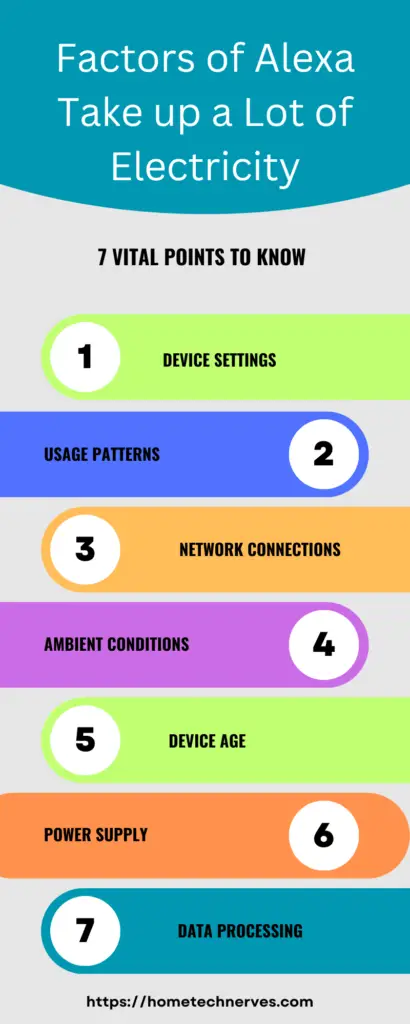As an expert in smart home technology, I have extensively researched the power consumption of popular devices like Alexa. Understanding the concerns surrounding energy usage is crucial.
Alexa, though efficient, can consume a moderate amount of electricity, depending on usage patterns and the specific model.
Let’s delve deeper into the query “Does Alexa take up a lot of electricity?” to uncover practical strategies for energy-conscious Alexa use.
Table of Contents
How Much Electricity Does Alexa Use per Hour?
The electricity consumption of Alexa can vary depending on the specific model and its usage. On average, an Alexa device consumes approximately 3 watts of power when actively in use.
When in standby mode, it uses around 2 watts. Over an hour, this translates to roughly 0.002 kilowatt-hours (kWh) during active use and 0.001 kilowatt-hours (kWh) in standby.
However, these values are approximate and can fluctuate based on the specific tasks being performed and the device’s settings.
How Many Watts Is the Echo Dot 4th Generation?
The 4th generation Echo Dot consumes around 15 watts when operating at its maximum capacity. This is an approximate value, and the actual power consumption may vary depending on the specific tasks being performed, the settings, and any connected accessories or features in use.
Does Echo Dot Use a Lot of Electricity?
The Echo Dot, like many other electronic devices, consumes a moderate amount of electricity. While the exact energy usage can vary based on the specific model and its usage patterns, it generally falls within a reasonable range.
With an average power consumption of around 15 watts during operation, the Echo Dot is designed to be energy-efficient.
However, to optimize energy usage further, it’s advisable to utilize power-saving features, such as standby mode and efficient usage practices, to minimize its overall electricity consumption.
How Much Electricity Does Alexa Show Use?
Alexa Show devices, which include models like the Echo Show and Echo Show 5, consume varying amounts of electricity depending on their specific models and usage patterns.
Generally, an Alexa Show device can consume approximately 20 to 30 watts during regular use. Standby power usage typically falls within a lower range, at around 10 to 15 watts.
It’s essential to note that these values are approximate and can fluctuate based on the device’s specific features, settings, and usage conditions.
For the most accurate information, please refer to the device’s official documentation or consult the manufacturer directly.
Factors of Does Alexa Take up a Lot of Electricity
When considering the electricity consumption of Alexa devices, several factors play a crucial role in determining their overall energy usage.
By understanding these key factors, users can make informed decisions to optimize energy efficiency and minimize electricity consumption.
Factors to Consider:
- Use frequency: Keep in mind the frequency and duration of interactions with Alexa to gauge its impact on electricity consumption.
- Device settings: Adjusting device settings, such as brightness and sound levels, can help regulate power usage and reduce energy consumption.
- Connected devices: Consider the power consumption of any additional devices or accessories connected to Alexa for a comprehensive assessment of energy usage.
- Standby mode: Implementing standby mode when not actively using Alexa can significantly reduce its overall electricity consumption.
- Software updates: Regularly updating Alexa’s software ensures optimal performance and may include energy-saving enhancements that improve overall efficiency.

How Many Watts Is Echo Dot (3rd Generation)?
The 3rd generation Echo Dot typically consumes about 15 watts when operating at its maximum capacity. This value can vary slightly depending on specific use cases and settings. I
It’s worth noting that Echo Dots are designed to be energy-efficient, aiming to minimize power consumption while providing users with the benefits of a smart assistant.
Wrap Up
In my experience, while Alexa and its associated devices do consume some electricity, they are generally designed to be energy-efficient.
Understanding the power consumption of these devices can help users make informed decisions about their overall energy usage.
By implementing simple practices such as utilizing standby mode and optimizing device settings, users can further reduce electricity consumption.
Overall, with careful management and awareness of usage patterns, Alexa’s impact on electricity bills can be minimized, allowing users to enjoy the benefits of smart home technology without significant energy concerns.
Frequently Asked Questions
Does Alexa consume a significant amount of electricity when idle?
No, Alexa devices consume minimal electricity when idle, typically ranging from 1 to 3 watts. Their energy-efficient design ensures that they consume very little power when not actively in use, helping to keep electricity costs low.
How much electricity does Alexa use when actively listening for commands?
When actively listening for wake words like “Alexa,” these devices consume slightly more electricity. However, this usage remains relatively low, with most Alexa devices consuming around 2 to 4 watts during active listening periods.
Can Alexa’s electricity consumption impact my utility bills significantly?
Alexa’s electricity consumption is generally negligible, even when used frequently throughout the day. While there may be a slight increase in electricity costs, it’s unlikely to have a significant impact on utility bills for most users due to its low power usage.
Are there ways to minimize Alexa’s electricity consumption further?
To reduce Alexa’s electricity consumption even further, users can enable features like “Brief Mode” to minimize Alexa’s responses, optimize device settings to reduce screen brightness (if applicable), and ensure devices are updated with the latest firmware for efficiency improvements.
References:
Amazon. Amazon Echo (3rd Generation) Power Consumption. https://www.amazon.co.uk/gp/help/customer/display.html?nodeId=GT97FYF689C9R434


